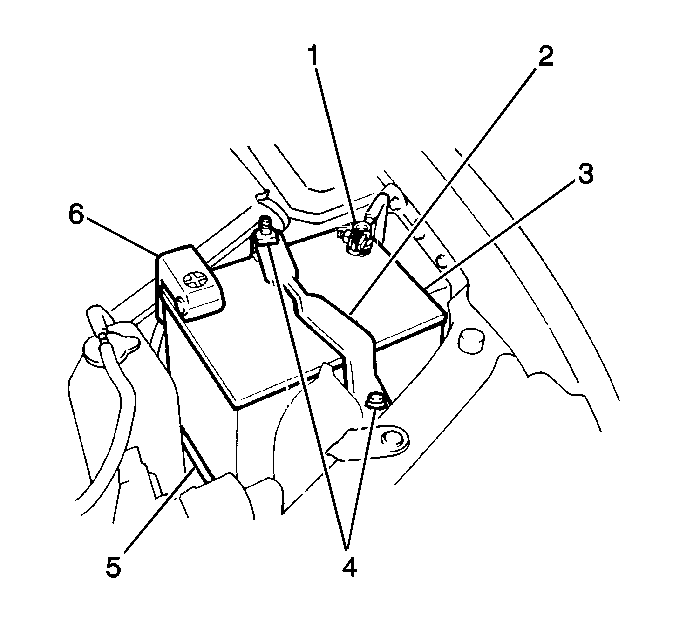Removal Procedure
- Disconnect the negative (-) battery cable.
- Remove the plastic insulator from the positive (+) battery terminal (6).
- Remove the nut from the positive (+) battery cables.
- Separate the positive (+) battery cable from the fuse and relay block 1 feed cable.
- Remove the battery from the vehicle. Refer to Battery Replacement .
- Remove the positive (+) battery cable from the harness retainers.
- Remove the positive (+) battery cable from the harness loom being careful not to damage the other wires in the harness.
- Disconnect the retaining nut and the cable from the starter solenoid.
- Remove the cable from the vehicle.
Caution: Unless directed otherwise, the ignition and start switch must be in the OFF or LOCK position, and all electrical loads must be OFF before servicing any electrical component. Disconnect the negative battery cable to prevent an electrical spark should a tool or equipment come in contact with an exposed electrical terminal. Failure to follow these precautions may result in personal injury and/or damage to the vehicle or its components.
Important: Whenever battery cables are being replaced, always be certain to use a replacement cable that is the same type, size and length. Some positive (+) cables have additional feed wires attached to them and some negative (-) cables have additional ground leads attached. Always be certain to route the replacement battery cable in exactly the same manner as the original cable.

Installation Procedure
- Position the positive (+) battery cable into the vehicle.
- Route the cable into the harness loom.
- Tape the loom to prevent dirt and moisture from entering the harness.
- Install the positive (+) battery cable to the harness retainers.
- Connect the cable to the starter solenoid. Secure the cable with the retaining nut.
- Install the battery to the vehicle. Refer to Battery Replacement .
- Install the positive (+) battery cable and the fuse and relay block 1 feed cable to the positive battery terminal.
- Install the nut from the positive (+) battery cables.
- Install the plastic insulator from the positive (+) battery terminal (6).
- Connect the negative (-) battery cable.

Notice: Use the correct fastener in the correct location. Replacement fasteners must be the correct part number for that application. Fasteners requiring replacement or fasteners requiring the use of thread locking compound or sealant are identified in the service procedure. Do not use paints, lubricants, or corrosion inhibitors on fasteners or fastener joint surfaces unless specified. These coatings affect fastener torque and joint clamping force and may damage the fastener. Use the correct tightening sequence and specifications when installing fasteners in order to avoid damage to parts and systems.
Tighten
Tighten the positive (+) battery cable-to-starter solenoid retaining
nut to 9 N·m (78 lb in).
Tighten
Tighten the negative (-) battery cable to 15 N·m
(11 lb ft).
